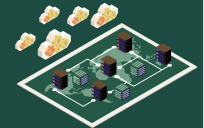![]()
One of my favorite parts of the Spaceship Earth ride at Disney’s Epcot is at the end of the ride when they have you answer questions that shape your vision of the city of the future. Those visions are not too far off: many American communities have already taken a giant leap into the future by equipping themselves with networks of sensors that make it possible to understand community data in a location-based context with real-time awareness. Not only are utility and infrastructure departments taking advantage of the capabilities that sensor data affords, but so are individuals with smartphones and other mobile devices. Citizens are connected with each other and to their governments via the vast Internet of Things (IoT). This network of connected devices enables easier, more open access to government data, and better decision-making on behalf of officials.
But mobile phones, tablet devices, and sensors on infrastructure aren’t the only way communities are making innovations in connectivity. Automated vehicles, which apply this same concept of sensor data driven decision-making, are one of the newest IoT innovations that cities can use to become smart communities, and governments can play a major role in helping build out the infrastructure needed to support this innovation.
One such automated vehicle, the connected car, uses real-time analytics to help bring a geographic context to road safety and driver convenience, by using sensors to collect data on a wide scale. Because the data points the cars collect have a location and time associated with them, spatial analytics will be a critical piece in how this data is processed, analyzed, and shared. The connected real-time analytics provided by the sharing of this information will also allow for a more personalized driving experience.
The spatial analysis done by the geographic information systems (GIS) in the connected car process and share data at a near real-time rate to emergency responders and other organizations. They can then use that data to better serve local communities. Spatial analysis through connected cars also has a world of potential to make the everyday lives of drivers more convenient by linking them to information hubs such as weather services, transportation departments, and other public agencies who in turn have geospatial access to data from sensors in the field and from other automated vehicles. For instance, in inclement weather, a connected car would take information about route preferences and sync that with real-time data from the local municipalities to help find the best route home. This data can also be collected to assist in better understanding driver behavior and trends within cities.
Car manufacturers recognize that by using GIS technology to “wire up” connected car information and perform real-time analytics, they can provide value added services; this is known as building a system of actuation. Actuation encompasses numerous connected sensors and devices and also the real-time, intelligent processes that control them. These new smart systems require understanding patterns and trends, making predictions, and actuating devices accordingly.
Cities must prepare, or actuate, for the impending ubiquity of automated vehicles as well. In order for Connected Cars to function successfully, and for communities to adapt to a whole host of new sensors hitting the road, states must prepare reliable data connections and ensure sufficient data transfer speeds between connected vehicles and infrastructure. These Vehicle-to-Infrastructure (V2I) deployments must also be compatible with the security policies and privacy requirements associated with connected vehicle environment applications.
In anticipation of this, the Federal Highway Administration has issued new guidelines to help state and local government agencies understand and prepare for this technology. This means determining which application options work well under what conditions, how they might integrate with existing traffic management and communication networks, and how initiatives can be funded. Transportation planners must also consider interoperability, as V2I deployments will have to integrate with light- and heavy-duty vehicles and transit systems in order to operate nationally.
Automated vehicles such as the connected car will function as massive data collection networks, whose capabilities to collect millions of data points during travel time will improve how we look at road networks and driver behavior, and how we engage with our communities. Making sure we, as communities, incorporate the building blocks for this network into our planned infrastructure upgrades will help ensure that the journey to connected cars is a smooth ride.
Christian Carlson is part of the GovLoop Featured Blogger program, where we feature blog posts by government voices from all across the country (and world!). To see more Featured Blogger posts, click here.





Leave a Reply
You must be logged in to post a comment.